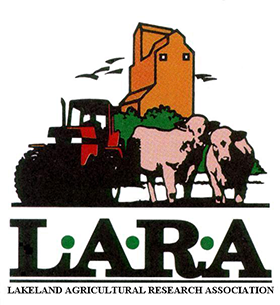Peola
Background:
High input costs, including fertilizer, has sparked producer interest in intercropping – the growing of two crops at the same time as a mixture in one field. Of particular interest is utilizing intercropping to improve multiple aspects of pea agronomy. The acres of cropland put in peas in Northeastern Alberta has decreased due to agronomic issues such as lodging, which can cause yield and quality loss at harvest. Development of semi-leafless pea varieties has improved lodging resistance compared to older varieties, although the problem can still remain an issue.
One method of improving standability is intercropping peas with canola. Previous research has shown that the canola crop can help prevent peas from lodging by providing a structure to hold up the pea vines. In return, the ability of peas to fix nitrogen could reduce fertilizer application rates and subsequently fertilizer costs. Planting peas and canola in a mixture could also reduce disease pressure due to the differences in crop competitiveness, nutrient use efficiency and growth habits which can help to outcompete weeds. As well, disease pressure could be decreased due to intercropping, which is an important consideration for crop production.
Another potential advantage to intercropping peas and canola is overyielding where the total yield per acre is higher when the two crops are grown together than when either is grown alone on the same acreage.
To assess the efficacy of growing peas and canola together, LARA began the Peaola trial in 2012 to look at the potentials of this intercropping system.
Objectives:
- To determine if peas and canola grown in an intercrop will over-yield when compared to either crops grown alone.
- To determine which mixture ratio is optimal for the production of peas and canola together.
- To determine if peas will have reduced lodging in a stand with canola.
Methods:
The trial was seeded on May 21, 2014 using the LARA five-row Fabro zero-till small plot drill in a completed randomized block design with four replicates. Cooper peas (green field pea) and 5525 CL canola were used and both seed lots were treated; peas were also inoculated. A list of treatments can be found in Table 1. Seeding was done in two passes with fertilizer in the first pass at ninety degrees to the seed rows. The crops were seeded in the second pass with canola seeded in the seed row at ¾” and the peas were side-banded in the fertilizer band at 1”. The plots were 1.15 m by 6 m in area. Target seeding rates were 75 plants/m2 for peas and 120 plants/m2 for canola. A soil test was taken in the spring and a blend of 33-4-3-6 was used and applied at 50% of the recommended rate. An in-crop spray of Odyssey was applied at the 4 node stage. The trial was harvested using a Wintersteiger combine on September 19, 2014. Following harvest, soil samples were taken to determine if there were differences in soil nutrient levels between treatments.
Table 1. Peaola treatment list, 2014

Results:
This was the third year that the trial has been grown at LARA and the results of the trial are summarized in Table 2. The highest yielding mixture treatments were those containing over 50% peas, which is in contrast to previous years where higher inclusion rates of canola led to increased yields. When pea plant density decreased to 50%, the yield of the mixtures dropped significantly. 2014 was a good year for growing peas and all of the LARA pea trials yielded very well.
Table 2. Peaola Trial Fort Kent, 2014.

The soil samples taken after harvest did not show any significant differences in soil N between the different treatments after harvest.
In support of the results found in previous studies, intercropping peas and canola resulted in minimal lodging. This provides an advantage when harvesting as the crop can be cut at a higher stubble length than peas alone, which increases ease of harvest.
To read more about Pulses, click here.
To read more about Oilseeds, click here.

